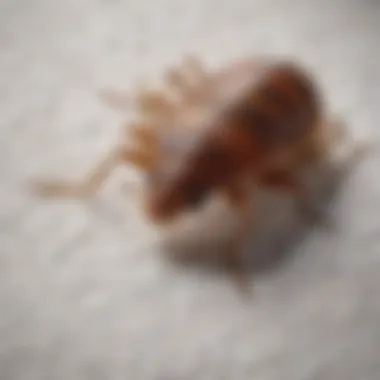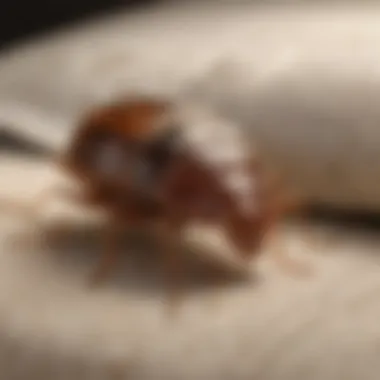Understanding the Risks of Spotting a Single Bed Bug


Intro
Finding even one bed bug can be alarming. Many people consider a single sighting as a mere coincidence. However, understanding what this means is crucial for effective pest management. This situation is often the beginning of more extensive issues. It is important to grasp the implications of spotting a solitary bed bug in your home environment.
Identification of Common Pests
Description of Common Pests
Bed bugs are small, parasitic insects that feed on the blood of humans and animals. They typically are about the size of an apple seed, with a brownish color. Other common pests that homeowners encounter may include cockroaches, ants, and termites. Each of these pests has unique traits and requirements for control. Bed bugs are notorious for their resilience and ability to reproduce quickly.
Signs of Infestation
Detecting bed bugs is not always straightforward. Key signs include:
- Bites: Often found in a linear pattern on exposed skin, bed bug bites can cause irritation.
- Fecal Spots: Small, dark droppings on bedding can indicate a problem.
- Shed Skins: Bed bugs molt as they grow. Finding these skins can signal a developing infestation.
- Eggs: Tiny white eggs, about the size of a pinhead, are another warning sign.
Finding a single bed bug, while unsettling, often warrants a detailed inspection of your living space. Immediate action is vital.
Prevention Techniques
Home Maintenance Tips
Preventative actions are essential to avoid infestations. Regular cleaning practices, such as vacuuming carpets and furniture, can help prevent bed bugs. It's wise to wash and dry bed linens on a high heat setting. Pay special attention to cracks and crevices in baseboards and furniture.
Environmental Modifications
Making specific changes in your home can help deter bed bugs. Consider
- Using bed bug covers for mattresses and pillows.
- Sealing openings where pipes, wiring, or ducts enter your home.
- Reducing clutter to minimize hiding spots for bed bugs.
Eco-Friendly Pest Control Options
Natural Pesticides
There are various eco-friendly options available for dealing with bed bugs. Natural pesticides contain ingredients that are less harmful to humans and pets. Examples include products made from diatomaceous earth or certain essential oils. These can deter bed bugs without heavy chemicals.
Organic Pest Control Techniques
Employing organic methods can help in managing pests. Methods such as steam cleaning, which heats the bugs and their eggs, can remove a problem without harmful substances. Traps can also be an effective, non-chemical way to monitor and catch pests before they multiply.
It is essential to understand that a single bed bug sighting should not be dismissed. Immediate evaluation and action can prevent a larger infestation.
For further information on bed bugs and pest management strategies, visit Wikipedia, or check out additional resources on Britannica.
Both homeowners and renters should be aware of the risks and know how to react if they spot even one bed bug in their living area.
The Relevance of a Single Bed Bug Sighting
Spotting a single bed bug in your home is often the first indication of a potential infestation. It is crucial to understand the implications that come with this sighting. Bed bugs are resilient pests. Their presence can disrupt everyday life. Ignoring a single sighting may lead to a more significant problem. Research shows that one bed bug can reproduce rapidly, leading to a full-blown infestation within weeks.
Understanding Bed Bug Biology
To grasp the true significance of spotting a bed bug, it is important to know its biology. Bed bugs are small, nocturnal insects that feed on the blood of humans and animals. They have a flat, oval shape and can be difficult to see, especially during the day. Adult bed bugs can survive several months without feeding, which complicates detection. Female bed bugs can lay hundreds of eggs in their lifetime, escalating the risks associated with a single sighting. Knowledge of their reproductive cycle is essential for effective pest management.


Behavior and Habits of Bed Bugs
Bed bugs are not only resilient but also highly adaptive. They tend to hide in crevices and cracks, making them hard to find. Their behavior is driven by their need for blood and their instinct to reproduce. Understanding their habits can help homeowners identify where these pests may hide. Bed bugs are often found in areas close to sleeping spaces. They can also spread through personal belongings such as luggage or clothing. Recognizing their behavior patterns is vital for addressing any potential infestation.
Assessing the Implications of a Sole Bed Bug
A single bed bug sighting should never be dismissed. It serves as a warning sign. After spotting one, homeowners must assess the situation critically. Look for the signs of potential infestation: dark spots from fecal matter, shedding skins, and bite marks on the skin. If these indications are present, it may signal a larger problem. It is best to act quickly to control the situation before it escalates. Evaluate the living environment and take appropriate measures to prevent a possible outbreak of bed bugs.
Signs of Bed Bug Infestation
Recognizing the signs of a bed bug infestation is crucial for any homeowner or renter. It enables timely intervention, which is key in managing these pests effectively. Bed bugs, while small, can cause significant discomfort and distress. They also have a reputation for being quite resilient. Thus, understanding their indicators can help in prevention before the problem escalates.
When addressing the signs of bed bug infestation, one must consider both physical and behavioral cues. Ignoring or dismissing initial sightings can lead to widespread issues. Thus, awareness of specific elements, benefits, and considerations related to signs of bed bugs is essential for an effective response.
Physical Indicators to Look For
Physical signs are often the first phase in identifying a bed bug presence. Homeowners should examine their living space for evidence such as:
- Bite Marks: These are typically a series of small, red, itchy welts. They often appear on exposed skin after sleep.
- Blood Stains: Small brown or red spots on bed sheets or mattresses can indicate crushed bed bugs or blood from feeding.
- Fecal Spots: Dark, tiny spots less than a millimeter in size found on sheets, walls, or mattress seams.
- Shed Skins: As bed bugs grow, they shed their skins. Finding these remains can be a strong indication of an infestation.
- Eggs and Eggshells: These are yellowish and tiny, often found in cracks and crevices near sleeping areas.
It is important to regularly inspect for these signs, especially if there’s a known risk of exposure, such as travel or second-hand furniture.
Common Locations for Bed Bug Activity
Bed bugs tend to inhabit areas where humans spend a considerable amount of time, making certain locales more susceptible than others. Common hiding spots include:
- Mattresses and Box Springs: These are prime locations where bed bugs can hide, making them crucial areas for inspection.
- Bed Frames and Headboards: The seams and joints of furniture are often overlooked yet can harbor these pests.
- Couches and Upholstered Furniture: Bed bugs can easily move from bedrooms to living areas, settling in fabric and seams.
- Baseboards and Carpets: The cracks in floorboards can serve as effective hiding spots.
- Luggage and Bags: If traveling, bed bugs can hitch a ride in your gear, leading to infestations once back home.
Homeowners should remain vigilant in examining these key areas regularly. Understanding where to look enhances the likelihood of early detection, allowing for more effective management of potential infestations.
Identifying Potential Risks
Spotting a single bed bug in your home can be a moment of concern. It’s not just an isolated incident; it can lead to various risks that extend beyond the immediate annoyance. Understanding these risks is essential for any homeowner or renter. It can help in making informed decisions about pest management and ensuring the comfort of your living environment. In essence, recognizing these potential risks is the first step in combating a possible infestation.
Health Risks Associated with Bed Bugs
Bed bugs are notorious for their bites, which can cause significant discomfort. When a bed bug bites, it injects saliva that can lead to allergic reactions in some individuals. These reactions manifest as red, itchy welts, which may require intervention. Furthermore, scratching these bites can lead to skin infections.
The mental health impact is also notable. The anxiety and stress associated with the thought of bed bugs can disrupt sleep and adversely affect overall well-being. Some studies suggest that prolonged exposure to an infestation can result in insomnia or anxiety disorders. This dual layer of physical and mental health implications emphasizes the importance of acting swiftly when a bed bug is sighted.
Economic Impact of Infestations
The economic consequences of a bed bug sighting can be quite significant. If left unaddressed, a single bed bug can lead to a full-blown infestation. The costs can escalate quickly, as pest control treatments are necessary to eliminate these pests. Professional extermination services can be expensive and may require multiple visits, depending on the level of infestation.
Let's break down some costs associated with a bed bug situation:
- Pest Control Services: Initial visits for extermination can range between $700 to $1,500, depending on the pest control company and the size of the home.
- Replacement Costs: If the infestation is severe, the need to replace mattresses, furniture, or other belongings can arise, leading to additional financial burden.
- Lost Productivity: For those who may need to take time off work or be unable to focus due to stress, there is an unseen economic impact.
In summary, the presence of a single bed bug is more than an annoyance; it signals the potential for health complications and economic loss. Ignoring it could lead to broader consequences that are costly and harmful.
Detection Strategies


Understanding detection strategies is crucial when it comes to managing a potential bed bug problem. These methods not only help identify the presence of these pests but also allow for more effective management before a small issue escalates into a larger infestation. Knowing how to spot bed bugs and where to look can make a significant difference in preventing widespread problems, thereby safeguarding your living space.
"Prompt detection is key to effective pest management, especially when dealing with bed bugs."
Visual inspections and specialized tools can both enhance your ability to detect these pests accurately. By employing a combination of techniques, homeowners can stay ahead in the fight against bed bugs.
Visual Inspection Techniques
To conduct a thorough visual inspection, one must be systematic and focused. First, it is important to know where bed bugs are likely to hide. Common places include cracks in walls, mattress seams, headboards, and furniture crevices. When inspecting, take the following steps:
- Check the Bed: Start with the mattress and box spring. Look at seams, folds, and tag areas for signs of bed bugs.
- Examine Surrounding Areas: Continue your inspection by checking nearby furniture, including nightstands and chairs.
- Look for Physical Indicators: Dark spots, which are excrement, shed skins, and bloodstains are significant indicators of bed bug activity.
- Consider Timing: Since bed bugs tend to be more active at night, inspecting during evening hours might yield better results.
Visual inspections should be thorough and use a flashlight for better visibility in dark areas. Regularly scheduled inspections can help catch early signs of infestation.
Using Detection Tools
In addition to manual inspections, there are several detection tools available that can enhance your ability to identify bed bugs. These tools may differ in their approaches and effectiveness.
- Bed Bug Monitors: These devices are designed to capture bed bugs as they travel. They work well when placed strategically in bed bug hotspots.
- Insect Lures and Traps: Some traps use pheromones to attract bed bugs, making it easier to confirm their presence.
- Smartphone Apps: Certain apps provide guidance on how to detect and manage infestations, offering tips and checklists that can be very helpful.
- Professional Bed Bug Detection Dogs: Highly trained dogs can sniff out bed bugs, even in hidden places. Engaging a professional service may be justified in cases of uncertainty.
When choosing detection tools, consider effectiveness, ease of use, and cost. Combining visual inspections with reliable tools can provide a comprehensive approach to detection, ensuring that any bed bugs spotted are addressed promptly.
Preventive Measures
Preventive measures are crucial in managing bed bug populations. The sighting of a single bed bug can signal potential risks. Thus, understanding how to effectively prevent infestations minimizes future issues. Being proactive not only protects personal space but also contributes to larger community health efforts.
Maintaining a Clean Home Environment
A clean home is the first line of defense against bed bugs. Regular cleaning practices can deter these pests from establishing a presence. Focus on high-traffic areas like bedrooms and living rooms. Things like bedding, curtains, and areas behind furniture can harbor these insects.
- Vacuum Regularly: Use a vacuum cleaner with a HEPA filter. This can trap bed bugs and their eggs effectively. Pay special attention to corners, cracks, and tight spaces. Dispose of the vacuum bag immediately after use to avoid re-infestation.
- Wash Bedding Frequently: Laundering bedding in hot water will kill bed bugs. Ensure to dry them on high heat as well. This not only removes potential infested materials but also disrupts any eggs that might be present.
- Declutter Your Space: Reducing clutter limits the number of hiding spots available for bed bugs. Evaluate items that you don't use regularly. Consider donating or recycling them to maintain a more organized living area.
- Inspect Second-Hand Items: If purchasing used furniture or clothing, examine them thoroughly. Bed bugs can lurk in seams and crevices, so look for signs before introducing new items into your home.
A clean home environment not only reduces the risk of bed bugs but also creates a more pleasant living space for you and your family.
Regular Inspections and Monitoring
Routine inspections act as an early warning system for potential bed bug infestations. Consistent monitoring helps catch problems before they escalate, making control efforts easier.
- Scheduled Checks: Develop a habit of inspecting key areas at least once a month. Focus on the mattress seams, box springs, and headboards. Additionally, inspect areas beneath furniture and behind baseboards.
- Use Detection Tools: Consider using bed bug detection tools like monitors or traps. These can provide continuous assessment of your home. Place them strategically in suspected areas.
- Appraise Travel Items: After returning from trips, check luggage and clothing thoroughly. Bed bugs are known to hitchhike. By inspecting before storing, you prevent bringing any unwanted guests into your home.
- Educate Your Family: Involving family members in the inspection process raises awareness. Teach them how to identify bed bugs and the signs of infestation. A household vigilant to changes can significantly reduce risks.
Regular inspections and maintaining a clean home environment work hand in hand in the broader strategy of bed bug management. Implementing these preventive measures enhances comfort and security at home.
Control Methods
The management of bed bugs requires careful consideration and effective control methods. This section explores the crucial control strategies available to homeowners and renters facing a potential infestation, including chemical and non-chemical options. Understanding these methods helps in making informed decisions when dealing with the stress that comes from spotting a single bed bug, which may indicate a more significant problem.
Chemical Treatments
Chemical treatments remain one of the most common methods for controlling bed bugs. These insecticides are specifically designed to target these pests effectively. One of the primary benefits of chemical treatments is their ability to eliminate bed bugs rapidly. Products containing pyrethroids, for instance, work by disrupting the nervous system of the insects, leading to their death.
However, there are some important considerations to keep in mind. Not all pests may respond to the same chemicals, as bed bugs have developed resistance to certain treatments over time. Therefore, it is prudent to identify the specific type of insecticide to use for the best results.


Important aspects of chemical treatments include:
- Targeted application: Focused application in infested areas can enhance effectiveness.
- Safety measures: Following safety instructions is crucial to prevent harm to occupants and pets.
- Environmental considerations: Some chemicals may have lasting effects on the environment.
Overall, chemical treatments can be effective, but they should be part of a broader strategy that includes monitoring and follow-up inspections.
Non-Chemical Alternatives
For those seeking less toxic options, non-chemical alternatives can be an effective way to control bed bug populations. These methods often focus on physical removal or reducing the contributing factors to infestations.
Some prevalent non-chemical strategies include:
- Heat treatments: Bed bugs are sensitive to extreme temperatures. Washing bedding and infested items in hot water and then drying them on high heat can eliminate bed bugs effectively.
- Vacuuming: Regular vacuuming of sleeping areas, furniture, and floors helps in reducing bed bugs. Ensure to dispose of vacuum bags immediately to prevent re-infestation.
- Encasements: Using specially designed mattress and box spring encasements can help trap bed bugs and prevent them from entering bedding. This method also makes it easier to monitor for signs of bed bug activity.
Adopting non-chemical approaches is beneficial for individuals concerned about chemical exposure. These methods can complement chemical treatments well, ensuring a more complete control of bed bugs.
"A dual approach using both chemical and non-chemical methods is often the most effective way to manage bed bug infestations."
In summary, both chemical treatments and non-chemical alternatives have their place in controlling bed bugs. Homeowners should evaluate their circumstances to determine the most appropriate strategies to implement.
When to Seek Professional Help
Spotting a single bed bug may seem manageable, but it can indicate a larger problem. Indeed, recognizing when to enlist professional help is crucial in preventing a small issue from quickly escalating into a substantial infestation. Understanding the signs and knowing the right time to take action are elements that can save homeowners significant time, stress, and money.
Indicators of Severe Infestation
There are several indicators that suggest a more serious situation than just a single bed bug sighting. Homeowners should be vigilant for these signs:
- Multiple sightings: If more bed bugs are spotted in various locations, this indicates a breeding population.
- Fecal stains: Dark spots on bedding, walls, or furniture, often a sign of bed bug droppings, signal their presence.
- Molted skins: Bed bugs shed their skin several times as they grow, and finding these skins points to an infestation.
- Bite marks: If multiple family members report bites, it's likely there are many bed bugs feeding at night.
- Odor: A musty scent in the area may come from the pheromones bed bugs emit, which can indicate a larger number of them present.
Recognizing these signs early can prevent a more significant infestation.
Selecting a Pest Control Expert
Choosing a reliable pest control expert is essential once the decision to seek professional help is made. Not all pest control services are equal, and selecting the right one requires careful consideration. Key factors to keep in mind include:
- Experience and Reviews: Look for companies with a proven track record and positive client reviews. Research platforms like Reddit or Facebook can provide insight into customer experiences.
- Methods Used: Inquire about the solutions they utilize. Ideally, they should offer a blend of chemical and non-chemical treatments to effectively handle the problem.
- Certification: Ensure that the pest control technicians are certified and trained specifically in bed bug management.
- Inspection Approach: A thorough inspection before application of any treatment should be conducted to assess the level of infestation.
Choosing a professional can offer peace of mind. Not only do they bring expertise, but they can also tailor a plan specific to your infestation scenario. This reduces the chances of recurrence and ensures that your living space is free from these pests.
"Addressing an infestation early can save you significant time and costs."
Taking the step to engage with experts can be the difference in effective bed bug management.
Closure
Recap of Key Points:
- Behavior and Habits: Bed bugs are elusive creatures. Recognizing their behavior helps in understanding how quickly they can multiply and what conditions they favor for survival.
- Detection and Prevention: The importance of regular inspections and maintaining cleanliness cannot be overstated. Being proactive in these areas can drastically reduce the risk of a full-blown infestation.
- Control Methods: Exploring both chemical and non-chemical treatment options gives people multiple tools to address the problem efficiently.
It is essential to remember that a solitary bed bug often signifies a detection challenge. Ignoring this can lead to more severe and costly issues.
Effective management strategies hinge on acknowledgment and swift action. We discussed how sometimes seeking professional assistance becomes necessary, particularly when indicators of a severe infestation present themselves. Being informed empowers individuals to protect their living spaces effectively.
Furthermore, maintaining an open line of communication with pest control professionals can also be beneficial. It fosters better understanding on both sides, allowing for custom management plans that consider the unique conditions of each home.
Final Thoughts on Bed Bug Management:
The stance one takes on bed bug management should not be approached lightly. Understanding the behavioral patterns of these pests, recognizing potential health risks, and being mindful of the economic implications are vital steps. Ultimately, timely intervention can prevent a minor inconvenience from escalating into a major disturbance.







